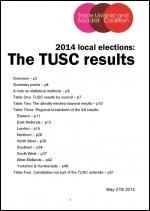A COMPREHENSIVE account of the TUSC results from last week’s local elections is now available at www.tusc.org.uk/wp-content/uploads/2022/11/307.pdf
A total of 554 candidates, standing in 507 wards in 86 councils, contested the local council elections on May 22nd under the Trade Unionist and Socialist Coalition (TUSC) umbrella. In addition, TUSC stood candidates in the directly-elected mayoral contests in Lewisham, Newham and Tower Hamlets, and in five by-elections in three councils without scheduled elections this year, that were held on the same day. In total 68,152 votes were cast for these candidates.
Scheduled elections took place in 161 local authorities in England, to fill 4,216 seats in around 3,000 wards. The TUSC challenge, contesting 12% of the seats and 17% of the wards, was greater than anything attempted before in the four-year history of our coalition. In 2011, the first local elections seriously contested by TUSC, we fielded a candidate in 2% of the seats. In 2012 it was 4% and in 2013, when it was mainly county councils which were up for election, TUSC had a candidate in 5% of the seats, 120 in total. This year was on a different scale.
But it was also on a different scale to any historical left-of-Labour comparator. The highest number of candidates ever stood by the Socialist Alliance, for example, was in 2002, on the same four-yearly local elections’ cycle as this year’s contests (including the London boroughs). The Socialist Alliance stood 204 candidates in those elections, in 187 wards. This really was, as we said, the biggest left-of-Labour electoral challenge since the immediate aftermath of world war two.
Trade unions
Another significant feature was the breadth of the candidates who came forward to stand. There were 53 candidates who were members of the RMT transport workers’ union, one of the constituent organisations, of course, of TUSC. But then there were 19 Communication Workers’ Union members who were candidates, 18 members of the National Union of Teachers, 16 PCS members, and 20 members of the University and College Union. From the big Labour-affiliated unions, there were 74 Unison members standing for TUSC and 130 members of Unite.
There was also political breadth, around the agreed TUSC core policies (see https://www.tusc.org.uk/policy ). The Trade Unionist and Socialist Coalition is, as the name states, a coalition. Alongside leading trade unionists and individual socialist councillors sitting in a personal capacity on the national steering committee, there are five organisations with official delegates to the committee: the RMT transport workers union, the Socialist Party, the Socialist Workers Party, Socialist Resistance, and the TUSC Independent Socialist Network, representing unaffiliated members of TUSC. These latter are an important component of TUSC – there were 141 candidates (25%) who, when completing the TUSC Authorisation Application form question, ‘are you a member of a political party or group?’ entered ‘none’.
But there were also candidates who are members of more socialist organisations than those currently participating on the national steering committee – as has been the case since TUSC’s formation. This year there were candidates standing under the TUSC umbrella who were members of DayMer (a socialist Turkish-Kurdish community group), the Pan-African Congress, the United Socialist Party, the Labour Representation Committee, and nine members of Left Unity and two Respect members, all with the rights guaranteed in the TUSC rules to promote their own organisation in their election campaign as they so wished (see https://www.tusc.org.uk/16861/14-11-13/How-TUSC-Functions on the TUSC website).
Media boycott
However, despite being the sixth biggest party in these elections, there was an almost total boycott of TUSC in the national broadcasting and print media, with just one item on the BBC’s Daily Politics show, a 20-second clip on the News At One, a similar length item on Radio Four, but nothing on ITV, Sky or Channel Four. The only national newspaper to mention TUSC was The Independent.
The BBC, acting on behalf of all the broadcasting companies, produces ‘guidance’ for how each election should be reported, including a minimum threshold of the number of candidates a party must stand before they qualify for ‘fair coverage’. Unfortunately, although we ended up with candidates in nearly 17% of the wards – above the BBC’s criteria – this time TUSC fell short of the seat number threshold and the steering committee is resolved that, if it is at all possible, this should be the last set of elections where this happens.
The election report includes the full results for each ward where a TUSC candidate stood, including the votes of all the other parties’ candidates, and the results of the TUSC candidates in the three directly-elected mayoral contests. It also presents, for the first time in our election reports, the TUSC results aggregated on a local authority basis – once again showing the scale of this year’s effort to build an anti-austerity alternative to the establishment parties.

